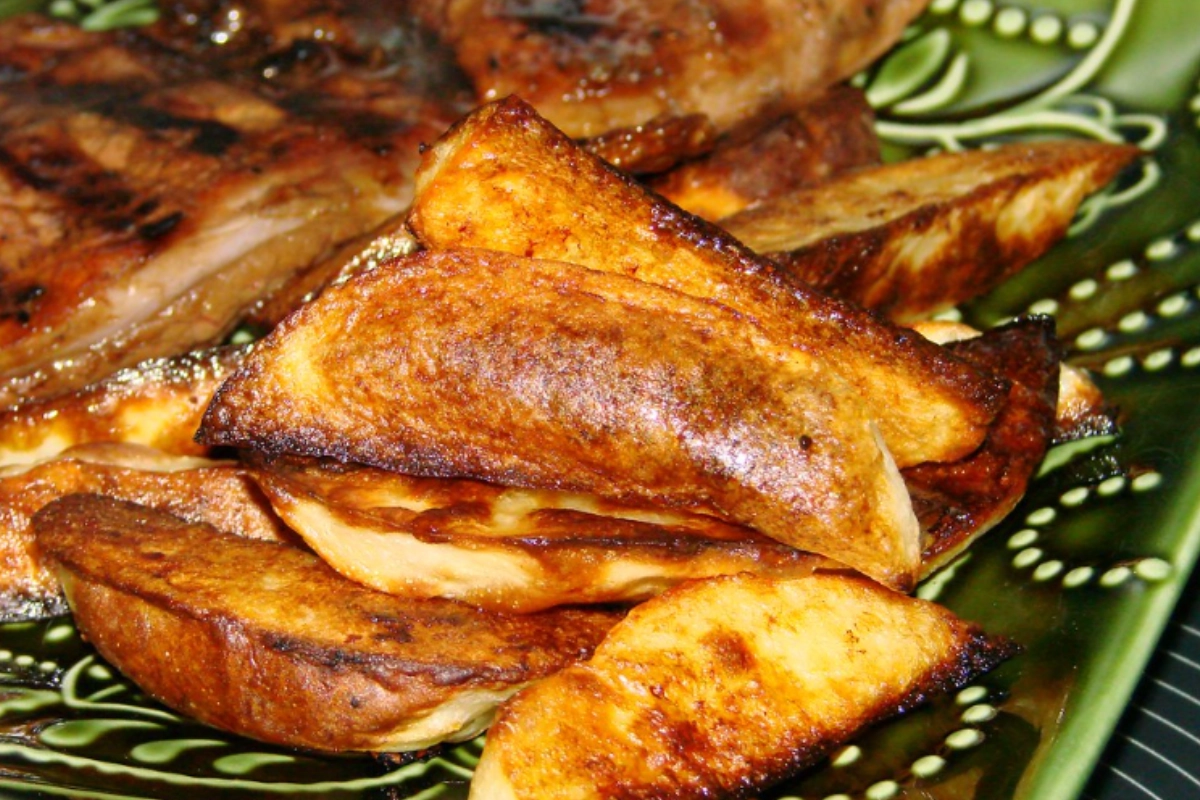Introduction
Ah, potato wedges! Isn’t it amazing how something as simple as a potato can be transformed into a crispy, fluffy, and utterly irresistible side dish? Whether served alongside a juicy burger or as a snack during a game night, potato wedges never disappoint. But, before we dive into the art of cutting the perfect wedge, let’s set the stage by understanding why choosing the right potato and prepping it correctly plays a pivotal role in the outcome of this beloved dish.
Preparing Your Potatoes
Before you can master the art of cutting potato wedges, proper preparation is key. From selecting the right type of potato to ensuring they’re clean and ready for slicing, each step is crucial in achieving the perfect wedge.
Choosing the Right Potato
The foundation of a great potato wedge is, unsurprisingly, the potato itself. Not all potatoes are created equal when it comes to baking and roasting. For wedges, you’ll want to look for starchy potatoes like Russets, which are ideal for their fluffy texture and ability to crisp up nicely. Yukon Golds are another excellent choice, offering a slightly buttery flavor and a creamy texture that holds up well when baked. For a detailed dive into the varieties of potatoes, explore different potato varieties at All About Potatoes.
Washing and Cleaning Potatoes
Once you’ve picked your potatoes, the next step is to ensure they are thoroughly washed. Dirt and contaminants can cling to the skin, so it’s important to rinse them under cold water first. After rinsing, use a vegetable brush or kitchen sponge to scrub the skin where most of the nutrients are concentrated. This step not only cleans the potatoes but also helps to maintain the nutritional integrity of their skins.
Storing Potatoes
Proper storage is essential to maintain the quality and longevity of your potatoes. Keep them in a cool, dark place like a pantry. Avoid storing potatoes in the refrigerator, as cold temperatures can convert their starch into sugar and alter their taste and cooking properties. A paper bag or a basket in a dark cupboard is ideal to ensure they stay dry and avoid sprouting. For more on potato storage, read up on Safe Knife Handling.
Necessary Tools and Safety Tips
Having the right tools at hand is crucial for cutting potatoes safely and efficiently. A sharp chef’s knife is necessary for clean cuts, and a sturdy cutting board will keep everything stable. Always keep your fingers tucked away from the blade and use a claw grip to hold the potato. This technique minimizes the risk of slipping and protects your fingers from cuts.
By taking the time to properly prepare, you ensure not only the quality of your wedges but also a safe and enjoyable cooking experience.
Step-by-Step Guide to Cutting Potato Wedges
Now that your potatoes are clean, dry, and ready, it’s time to transform them into the perfect wedges. This step-by-step guide will walk you through the process, ensuring that each wedge is cut to perfection for even cooking and optimal crispiness.
Step 1: Halving the Potato
Start by placing the potato on its side on your cutting board. Using your sharp chef’s knife, slice the potato in half lengthwise. This initial cut is crucial as it sets the stage for uniform wedges. Make sure the cut is straight and centered to divide the potato into two equal halves.
Step 2: Quartering the Potato
Take each half of the potato and lay them cut side down on the board for stability. Cut each half in half again, lengthwise. You now have four quarters from one potato. This step is about precision, as equal quarters mean equally sized wedges, which are essential for even cooking.
Step 3: Creating Wedges
Now, take each quarter and place it cut side up. Carefully slice down the center of the quarter to create two wedges. This final cut determines the shape of your wedges, so aim for a consistent angle and thickness. For larger potatoes, you might need to cut each of these pieces again to ensure they are not too bulky, which can affect their cooking time and crispiness.
Optional Techniques for Different Wedge Sizes
Depending on your preferences or the dish you are preparing, you might want to adjust the size of your wedges:
- Thinner Wedges: For a crispier outcome, cut each quarter into three or more wedges. Thinner wedges cook faster and offer more surface area for crispiness.
- Thicker Wedges: For a softer, heartier wedge, limit your cuts to make fewer, thicker wedges. These are great for dipping and can be more satisfying as a side dish.
By following these detailed steps, you ensure that each potato is cut into wedges that will cook evenly and offer that perfect balance of crispy exterior and fluffy interior. Whether you’re serving them alongside a main dish or as a snack with your favorite dips, these potato wedges are sure to be a hit!
Seasoning and Cooking Tips
Once you’ve mastered the art of cutting potato wedges, the next step is to season and cook them to perfection. Here’s how to infuse flavor into your wedges and choose the best cooking method to achieve the ideal texture and taste.
Seasoning Blends
The right seasoning can elevate your potato wedges from good to extraordinary. Before seasoning, toss the wedges in a light coating of oil — this helps the seasoning stick and promotes an even, crispy exterior. Here are some popular seasoning blends to try:
- Classic: A simple mix of salt, pepper, and garlic powder gives a robust flavor that pairs well with almost any dish.
- Spicy: Add some heat with chili powder, cayenne pepper, or smoked paprika for a kick.
- Herbal: Rosemary, thyme, and oregano offer a Mediterranean touch that is both aromatic and flavorful.
- Cheesy: For a cheesy flavor without actual cheese, nutritional yeast can be a great addition, especially for those following a vegan diet.
Experiment with different combinations to find your favorite or tailor the seasonings to complement the main dish you’re serving with the wedges.
Cooking Methods
The cooking method you choose can significantly affect the texture and flavor of your potato wedges. Here are three popular methods:
- Baking: Preheat your oven to 400°F (200°C) and arrange the wedges on a baking sheet in a single layer, ensuring they don’t touch each other. Bake for 25-35 minutes, flipping halfway through, until golden and crispy.
- Roasting: Similar to baking, but at a higher temperature. Roast the wedges at 425°F (220°C) for a shorter period to achieve a crispier exterior.
- Air-frying: For those who prefer a healthier option, air-frying uses significantly less oil. Preheat your air fryer and cook the wedges at 380°F (193°C) for about 20-25 minutes, shaking the basket halfway through cooking.
Each method has its benefits, so choose based on your texture preference and the tools you have available.
By carefully selecting your seasonings and cooking method, you can ensure that your potato wedges are not only delicious but also perfectly tailored to your taste and dietary preferences. Whether you’re looking for a snack during a movie night or a side dish for a family dinner, these potato wedges will not disappoint!
How to Cut Gordon Ramsay Potato Wedges
Gordon Ramsay, renowned for his culinary expertise, suggests a method for cutting potato wedges that ensures they are even in size for consistent cooking. Here’s how you might approach it based on his style:
- Select the Right Potatoes: Opt for starchy potatoes like Russets for the best texture.
- Clean and Prepare: Thoroughly wash the potatoes to remove any dirt. You can peel them if you prefer, but leaving the skin on can add texture and flavor.
- Cutting the Wedges:
- Slice the potato in half lengthwise.
- Place the flat side down on the cutting board for stability.
- Cut each half into three or four wedges, depending on the size of the potato, making sure each wedge is similar in thickness.
This method is straightforward and focuses on creating wedges that will cook evenly.
What Does It Mean to Cut into Wedges?
Cutting into wedges refers to slicing a round or oval object (like a potato) into triangular sections that maintain a bit of the object’s original shape. This method is commonly used for fruits and vegetables and is particularly popular for items like potatoes, apples, and tomatoes, where the wedge shape is ideal for baking or frying.
The Proper Way to Cut Potatoes
The proper way to cut potatoes depends on the intended dish. For wedges:
- Wash the Potatoes: Start with clean potatoes.
- Slice in Half: Place the potato on its side and cut it down the center.
- Quarter and Wedge: Place the cut side down, slice into quarters, and then cut each quarter into one or two wedges, depending on desired size.
This method ensures that the wedges are uniform, which helps in cooking them evenly.
How Do You Cut Big Wedges?
For larger wedges, suitable for bigger potatoes or for a more substantial side dish:
- Halve the Potato: Start by cutting the potato in half lengthwise.
- Quarter Each Half: Depending on the potato’s size, you may wish to cut each half into just two wedges if the potatoes are very large.
- Cutting Larger Wedges: Instead of slicing each quarter into multiple pieces, simply cut each quarter into one wedge. This will result in bigger and thicker wedges, which may require slightly longer cooking times.
Conclusion
In conclusion, learning how to cut potato wedges is a simple yet rewarding skill that can elevate your cooking repertoire. By following the step-by-step guide outlined in this article, you can create perfect potato wedges every time, customized to your taste preferences. Whether you prefer them baked, fried, or air-fried, potato wedges are a versatile and delicious side dish or snack that is sure to please everyone at the table. So next time you’re craving something crispy and satisfying, consider making your own potato wedges at home—it’s easier than you think!
FOR MORE RECIPE CLICK HERE

